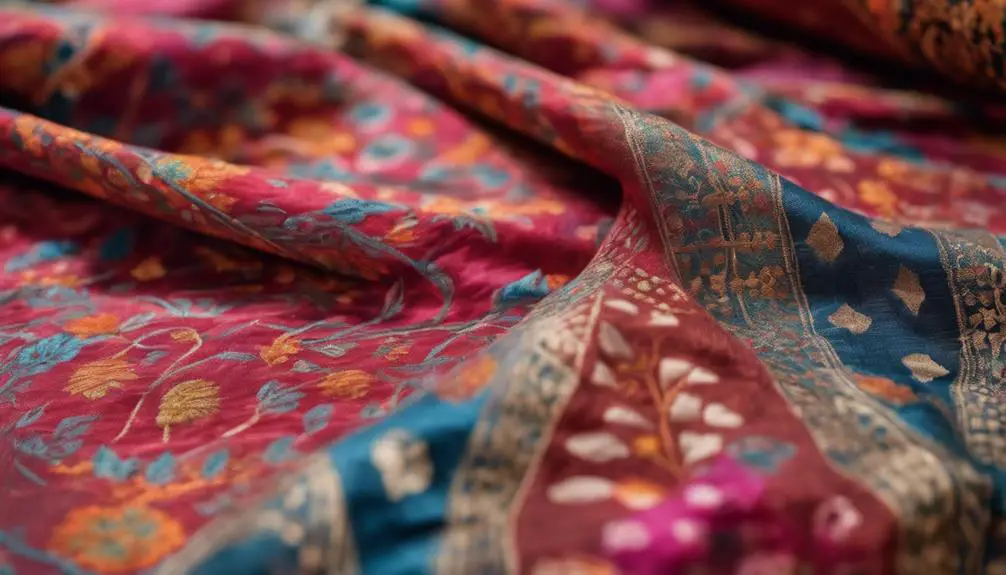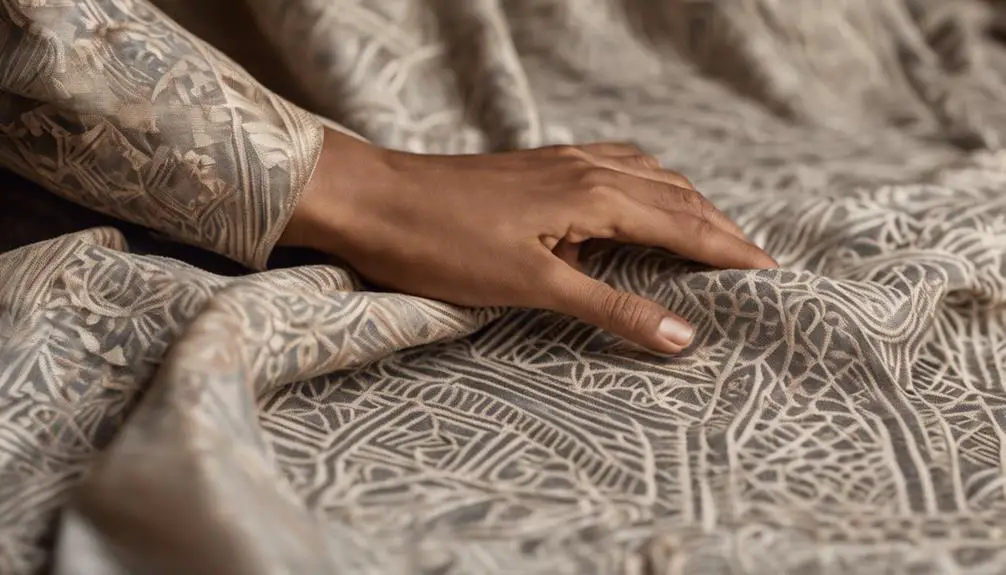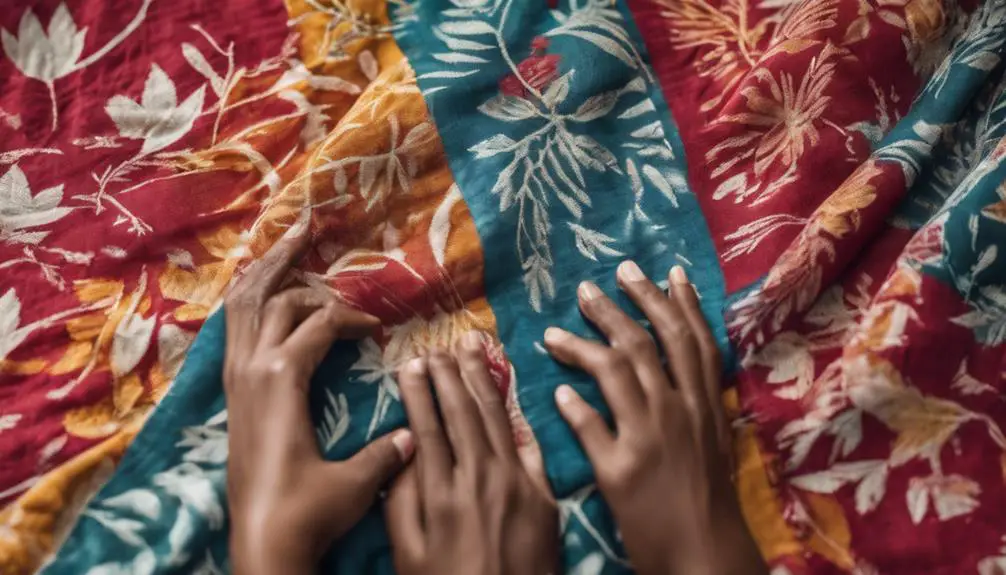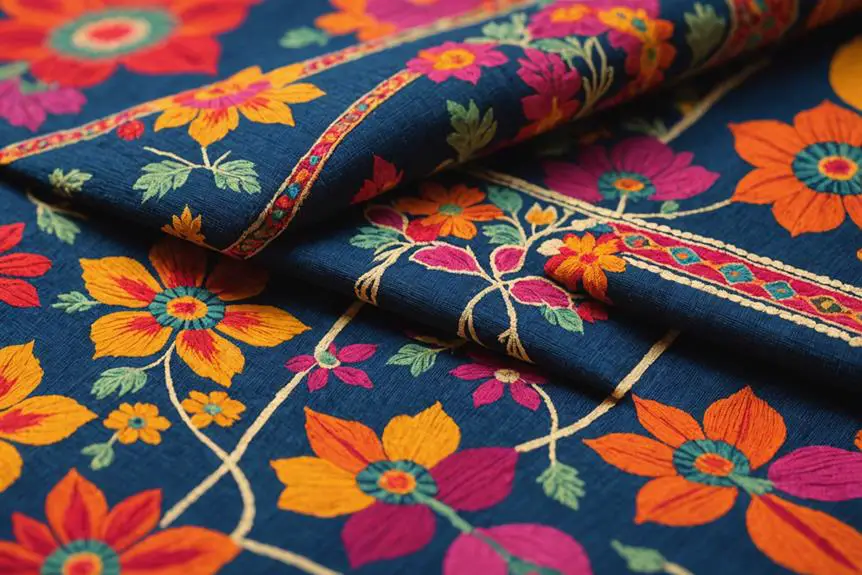When you're trying to identify authentic Jamdani fabric, you should start by examining its lightweight and breathable texture, often made from pure cotton or a cotton-silk blend. Pay attention to the intricate, nature-inspired designs that utilize the supplementary weft technique, showcasing slight irregularities that speak to handloom craftsmanship. Don't overlook labels that mention the weaver's name and location, which can be vital for authenticity. But what if you miss some key indicators? Understanding these finer points could change how you view your textile choices entirely.
Characteristics of Jamdani Fabric

When you explore Jamdani fabric, you'll notice several key characteristics that set it apart. First off, it's lightweight and breathable, making it super comfy to wear. You'll love how it feels soft against your skin, thanks to the pure cotton or cotton-silk blend that gives it a nice natural sheen. But what really makes Jamdani unique are its intricate and delicate designs.
Using the supplementary weft technique, artisans create beautiful, nature-inspired motifs that look like mirror images on both sides. Isn't that cool? When you're trying to identify authentic Jamdani, keep an eye out for the slightly irregular weave. That's a sign of genuine craftsmanship, and it shows just how much time and effort goes into making each piece.
You might notice some unique imperfections in the fabric, which really adds to its charm. Unlike machine-made versions, these quirks make each Jamdani fabric one-of-a-kind, just like you! Look for geometric and floral patterns that reflect the rich culture of the Bengal region—those are the telltale signs of authentic Jamdani.
Weaving Techniques and Patterns
The artistry of Jamdani fabric lies in its unique weaving techniques and patterns that showcase the skill of the artisans. You'll find that Jamdani uses a supplementary weft technique, which means extra threads are woven into the fabric. This creates those intricate designs and motifs you see, and it's all done by hand. Isn't that amazing?
As you admire a Jamdani saree, notice how patterns can stretch continuously along its entire length. This isn't just for show; it takes a lot of skill to keep the designs consistent! Plus, if you come across something called cutwork Jamdani, you'll discover it involves cutting away excess threads after weaving. This adds a unique texture and depth to the motifs, making them really stand out.
Now, each motif is carefully crafted, ensuring that authentic patterns remain clear and precise. This clarity is a telltale sign of skilled handloom craftsmanship. You can almost feel the love and care in those designs! And let's not forget the tactile experience. The unevenness and organic texture of genuine Jamdani weaves set them apart from machine-made fabrics. Who wants bland when you can have something that feels alive in your hands?
Identifying Authenticity Indicators

Identifying authentic Jamdani fabric can feel overwhelming, but knowing what to look for makes it easier. When you're shopping for Jamdani sarees, there are some key indicators you should keep in mind. First off, check for labels or tags that mention the weaver's name and their location. This can help you identify an authentic Jamdani and assure you that it's genuine Jamdani.
Next, take a look at the fabric's composition. Genuine Jamdani is usually made from pure cotton or a cotton-silk blend. If you spot synthetic fibers, it's a red flag! Also, don't be surprised if authentic pieces come with a higher price tag. The extensive labor and craftsmanship involved in the weaving technique mean these sarees are truly special.
Now, let's talk about the patterns. Authentic Jamdani fabrics boast intricate designs that are well-defined and consistent. If you see any imperfections or a lack of detail, you might be looking at a machine-made version. It's essential to recognize that some genuine Jamdani items even come with documentation or certificates confirming their authenticity, helping you avoid look-alike products.
Importance of GI Tags
GI tags play an essential role in the world of Jamdani fabric, guaranteeing both authenticity and quality. When you spot a GI tag on a piece of Jamdani fabric, you can feel confident knowing that it comes from a specific region, like Dhaka, Bangladesh, or parts of West Bengal. This tag assures that the fabric isn't just any ordinary weave; it's a product of traditional craftsmanship.
Why are GI tags so important? Here are a few reasons:
- Authenticity: They certify that the fabric is genuine and handwoven.
- Protection Against Counterfeit: The tag helps you avoid fake products that don't have the same quality.
- Support for Weavers: By promoting traditional crafts, GI tags help local artisans thrive.
- Quality Assurance: They guarantee that the fabric meets specific standards, so you get the best.
- Cultural Heritage: The tag preserves the rich history and techniques of Jamdani weaving.
Care and Maintenance Tips

Maintaining the beauty and integrity of Jamdani fabric requires some careful attention. First off, it's essential to air the fabric regularly. This means giving it some fresh air rather than letting it sit in a dark closet. Also, keep your Jamdani away from direct sunlight, which can fade those vibrant colors over time. You don't want your favorite saree to look like it's been sunbathing too long!
When it comes to cleaning, dry-cleaning is your best friend. Water can weaken the delicate fibers and distort those stunning motifs that make Jamdani special. So, resist the urge to toss it in the wash—your fabric will thank you!
For storage, always roll your Jamdani pieces in a cotton cloth. Folding can cause nasty creases, and we certainly don't want that! Rolling helps maintain the fabric's natural shape. Plus, wrapping them in breathable cotton fabric protects against dust and pesky insects, while still letting air circulate—like a mini vacation for your saree!
Lastly, steer clear of harsh chemicals or strong detergents when cleaning. These can damage the natural fibers and mess with the colorfastness. Remember, a little care goes a long way! With these simple maintenance tips, your Jamdani fabric will stay as beautiful as the day you got it. Now, isn't that worth it?
Frequently Asked Questions
What Are the Characteristics of Jamdani Fabric?
Jamdani fabric's got some amazing characteristics that really stand out! You'll notice the unique Jamdani weaving technique creates a lovely texture, giving it a soft, breathable feel. Look for traditional motifs inspired by nature, like flowers and geometric shapes, adding vibrant color variations that pop! Plus, it's not just fabric; it holds cultural significance, showcasing skilled craftsmanship. Isn't it cool how something so beautiful can tell a story? You'll definitely appreciate its charm!
What Is the Difference Between Jamdani and Dhakai Jamdani?
So, you're curious about the difference between Jamdani and Dhakai Jamdani? Well, both involve amazing Jamdani weaving techniques, but Dhakai Jamdani shines with its intricate motifs that reflect Dhakai heritage. While regular Jamdani has its charm, Dhakai's exquisite detailing comes from skilled Jamdani artisans who pour their heart into every piece. It's like comparing a cool doodle to a masterpiece! Plus, Dhakai's rich history makes it a treasure worth exploring. Isn't that neat?
What Is the Difference Between Jacquard and Jamdani?
So, what's the deal between Jacquard and Jamdani? Well, Jamdani's all about traditional weaving. It showcases intricate patterns that reflect cultural significance, thanks to skilled artisans. On the flip side, Jacquard uses machines for quicker production, creating uniform designs. While Jamdani tells stories through its textile history, Jacquard's designs can be more abstract. Isn't it cool how each fabric brings its own flair? You can really feel the love and craftsmanship in Jamdani!
What Is the Difference Between Muslin and Jamdani?
So, you wanna know the difference between muslin and Jamdani? Muslin's all about lightweight, plain weaving, while Jamdani weaving brings in those stunning patterns! Imagine the fabric origins; muslin is quick to make, but Jamdani takes days of skilled work. Plus, Jamdani has historical significance, often linked to cultural heritage. When caring for them, remember—delicate Jamdani needs gentle washing, while muslin's pretty low-maintenance. Isn't fabric fascinating?
Conclusion
So, there you have it! Identifying Jamdani fabric isn't just about looking good; it's about appreciating the artistry and effort behind each piece. Remember to check for that airy texture and those unique patterns. And don't forget to look for the weaver's name—it's like finding a hidden treasure! With a little practice, you'll be spotting authentic Jamdani like a pro. Isn't it cool to wear something that's both beautiful and meaningful? Happy fabric hunting!





Plunge into the massive galaxy of EVE Online. Forge your empire today. Conquer alongside millions of pilots worldwide. [url=https://www.eveonline.com/signup?invc=46758c20-63e3-4816-aa0e-f91cff26ade4]Download free[/url]